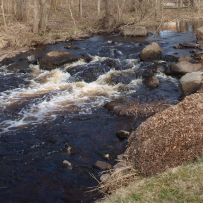Fate of terrestrial organic matter in the marine environment

What happens when rivers deliver terrestrial organic matter to the marine environment?
Currently, as part of the Managing Multiple Stressors in the Baltic Sea Project (a FORMAS Strong Research Environment), I am investigating the character and fate of terrestrially-derived dissolved organic matter (t-DOM) as it enters the Baltic Sea. In the sea, a variety of processes, both biotic and abiotic, can transform and even remove t-DOM from the dissolved organic pool. The character of the t-DOM is what controls its fate in the marine system, and how it participates in the global carbon cycle. I use a variety of analytical techniques to characterize the organic matter present in river mouths just before they enter the Baltic Sea. In particular, electrospray-ionization mass spectrometry allows us to create a molecular fingerprint of the organic matter as it is before it enters the Baltic, and then after it has been subjected to the various processes (photochemistry, microbial degradation, flocculation etc.) that can occur in the marine environment. With this information I hope to understand how the terrestrial environment influences the Baltic Sea. With a greater understanding of the mechanisms driving organic matter cycling in marine systems, we can gain further insight into our global environment.
For more information about the Multistressors Project check out the project webpage!
